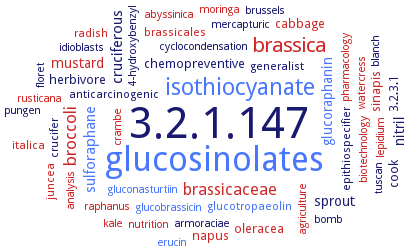3.2.1.147: thioglucosidase
This is an abbreviated version!
For detailed information about thioglucosidase, go to the full flat file.

Word Map on EC 3.2.1.147 
-
3.2.1.147
-
glucosinolates
-
isothiocyanate
-
brassica
-
broccoli
-
brassicaceae
-
sulforaphane
-
cruciferous
-
nitril
-
glucoraphanin
-
mustard
-
sprout
-
oleracea
-
herbivore
-
napus
-
cook
-
chemopreventive
-
sinapis
-
cabbage
-
radish
-
juncea
-
crucifer
-
epithiospecifier
-
anticarcinogenic
-
italica
-
brassicales
-
3.2.3.1
-
glucotropaeolin
-
generalist
-
armoraciae
-
rusticana
-
watercress
-
bomb
-
floret
-
idioblasts
-
cyclocondensation
-
kale
-
abyssinica
-
glucobrassicin
-
4-hydroxybenzyl
-
raphanus
-
analysis
-
pharmacology
-
tuscan
-
gluconasturtiin
-
erucin
-
mercapturic
-
brussels
-
nutrition
-
agriculture
-
moringa
-
lepidium
-
pungen
-
crambe
-
blanch
-
biotechnology
- 3.2.1.147
- glucosinolates
- isothiocyanate
- brassica
- broccoli
- brassicaceae
- sulforaphane
-
cruciferous
-
nitril
- glucoraphanin
- mustard
- sprout
- oleracea
-
herbivore
- napus
-
cook
-
chemopreventive
- sinapis
- cabbage
- radish
- juncea
-
crucifer
-
epithiospecifier
-
anticarcinogenic
- italica
- brassicales
-
3.2.3.1
- glucotropaeolin
-
generalist
-
armoraciae
- rusticana
- watercress
-
bomb
- floret
- idioblasts
-
cyclocondensation
- kale
- abyssinica
- glucobrassicin
-
4-hydroxybenzyl
- raphanus
- analysis
- pharmacology
-
tuscan
- gluconasturtiin
- erucin
-
mercapturic
-
brussels
- nutrition
- agriculture
- moringa
- lepidium
-
pungen
- crambe
-
blanch
- biotechnology
Reaction
Synonyms
ArMy2, AtBGLU37, AtBGLU38, atypical myrosinase, beta-glucosidase 26, peroxisomal, beta-glucosidase 37, beta-glucosidase 38, beta-thioglucosidase, beta-thioglucosidase glucohydrolase, beta-thioglucoside glucohydrolase, beta-thioglucoside glucohydrolase,, BGLU26, CpTGG1, CpTGG2, EC 3.2.3.1, glucosidase, thio-, glucosinolase, More, MYR, MYR II, MYR1 myrosinase, Myr1.Bn1, Myr2.Bn1, MYRc, MYRI, MYRII, myrosin, myrosinase, myrosinase 1, myrosinase 2, myrosinase A, myrosinase B, PEN2, PYK10 myrosinase, sinigrase, sinigrinase, sinigrinase 1, sinigrinase 2, TGG, TGG1, TGG2, TGG4, TGG5, Thioglucosidase, thioglucosidase 1, thioglucosidase 2, thioglucoside glucohydrolase, thioglucoside glucohydrolase 1, thioglycosidase, WjMYR


 results (
results ( results (
results ( top
top





